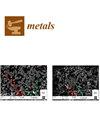Shape Anisotropy of Grains Formed by Laser Melting of (CoCuFeZr)17Sm2
IF 2.5
3区 材料科学
Q3 MATERIALS SCIENCE, MULTIDISCIPLINARY
引用次数: 0
Abstract
For permanent magnetic materials, anisotropic microstructures are crucial for maximizing remanence Jr and maximum energy product (BH)max. This also applies to additive manufacturing processes such as laser powder bed fusion (PBF-LB). In PBF-LB processing, the solidification behavior is determined by the crystal structure of the material, the substrate, and the melt-pool morphology, resulting from the laser power PL and scanning speed vs. To study the impact of these parameters on the textured growth of grains in the melt-pool, experiments were conducted using single laser tracks on (CoCuFeZr)17Sm2 sintered magnets. A method was developed to quantify this grain shape anisotropy from electron backscatter diffraction (EBSD) analysis. For all grains in the melt-pool, the grain shape aspect ratio (GSAR) is calculated to distinguish columnar (GSAR < 0.5) and equiaxed (GSAR > 0.5) grains. For columnar grains, the grain shape orientation (GSO) is determined. The GSO represents the preferred growth direction of each grain. This method can also be used to reconstruct the temperature gradients present during solidification in the melt-pool. A dependence of the melt-pool aspect ratio (depth/width) on energy input was observed, where increasing energy input (increasing PL, decreasing vs) led to higher aspect ratios. For aspect ratios around 0.3, an optimum for directional columnar growth (93% area fraction) with predominantly vertical growth direction (mean angular deviation of 23.1° from vertical) was observed. The resulting crystallographic orientation is beyond the scope of this publication and will be investigated in future work.激光熔化 (CoCuFeZr)17Sm2 形成的晶粒的形状各向异性
对于永磁材料来说,各向异性的微结构对于最大限度地提高剩磁 Jr 和最大能量积 (BH)max 至关重要。这同样适用于激光粉末床熔融(PBF-LB)等增材制造工艺。在 PBF-LB 加工过程中,凝固行为由材料的晶体结构、基体和熔池形态决定,而熔池形态则由激光功率 PL 和扫描速度 vs 决定。为了研究这些参数对熔池中晶粒纹理生长的影响,我们在 (CoCuFeZr)17Sm2 烧结磁体上使用单激光轨迹进行了实验。通过电子反向散射衍射 (EBSD) 分析,开发了一种量化晶粒形状各向异性的方法。对于熔池中的所有晶粒,通过计算晶粒形状长宽比 (GSAR) 来区分柱状晶粒(GSAR < 0.5)和等轴晶粒(GSAR > 0.5)。对于柱状晶粒,可确定晶粒形状取向(GSO)。GSO 代表每个晶粒的优先生长方向。这种方法还可用于重建熔池凝固过程中的温度梯度。观察到熔池纵横比(深度/宽度)与能量输入有关,能量输入增加(PL 增加,VS 减小)会导致纵横比增加。在长宽比为 0.3 左右时,观察到定向柱状生长的最佳状态(面积分数为 93%),生长方向主要是垂直的(与垂直方向的平均角度偏差为 23.1°)。由此产生的晶体学取向超出了本出版物的范围,将在今后的工作中进行研究。
本文章由计算机程序翻译,如有差异,请以英文原文为准。
求助全文
约1分钟内获得全文
求助全文
来源期刊

Metals
MATERIALS SCIENCE, MULTIDISCIPLINARY-METALLURGY & METALLURGICAL ENGINEERING
CiteScore
4.90
自引率
13.80%
发文量
1832
审稿时长
1.5 months
期刊介绍:
Metals (ISSN 2075-4701) is an open access journal of related scientific research and technology development. It publishes reviews, regular research papers (articles) and short communications. Our aim is to encourage scientists to publish their experimental and theoretical results in as much detail as possible. Therefore, there is no restriction on the length of the papers. The full experimental details must be provided so that the results can be reproduced. Metals provides a forum for publishing papers which advance the in-depth understanding of the relationship between the structure, the properties or the functions of all kinds of metals.
 求助内容:
求助内容: 应助结果提醒方式:
应助结果提醒方式:


